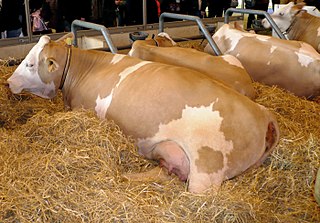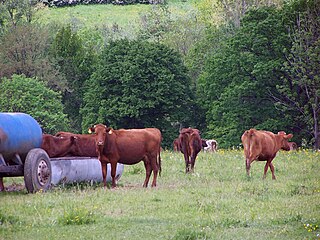Related Research Articles

The Dutch Belted breed of dairy cattle is, according to records, the only belted breed of cattle tracing back directly to the original belted or "canvassed" cattle which were described in Switzerland and Austria. These Gurtenvieh were evidently moved by Dutch nobility from the mountain farms of canton Appenzell and County of Tyrol during or soon after the feudal period. The Dutch were very protective of their belted cattle and would generally not part with them. The cattle were highly prized for their milking and fattening abilities. The breed began to flourish in the Netherlands around 1750. Now, the cow is too rare to become a popular type of beef.

The Alpine Dachsbracke is a small breed of dog of the scent hound type originating in Austria. The Alpine Dachsbracke was bred to track wounded deer as well as boar, hare, and fox. It is highly efficient at following a trail even after it has gone cold. The Alpine Dachsbracke is very sturdy, and Austria is said to be the country of origin.

A Schnauzer is a dog breed type that originated in Germany from the 14th to 16th centuries. The term comes from the German word for "snout" and means colloquially "moustache", or "whiskered snout", because of the dog's distinctively bearded snout. Initially it was called Wire-Haired Pinscher, while Schnauzer was adopted in 1879.

The Guernsey is a breed of dairy cattle from the island of Guernsey in the Channel Islands. It is fawn or red and white in colour, and is hardy and docile. Its milk is rich in flavour, high in fat and protein, and has a golden-yellow tinge due to its high β-carotene content. The Guernsey is one of three Channel Island cattle breeds, the others being the Alderney – now extinct – and the Jersey.

Braunvieh, in English Swiss Brown or Brown Swiss, is a breed or group of breeds of domestic cattle originating in Switzerland and distributed throughout the Alpine region. They are a member of the "Brown Mountain" group of cattle breeds. The Braunvieh was originally a triple-purpose breed, used for milk production, for meat and for draught work; the modern Braunvieh is predominantly a dairy breed.

The Gir or Gyr is one of the principal Zebu breeds originating in India. It has been used locally in the improvement of other breeds including the Red Sindhi and the Sahiwal. It was also one of the breeds used in the development of the Brahman breed in North America. In Brazil and other South American countries the Gir is used frequently because, as a Bos indicus breed, it is resistant to hot temperatures and tropical diseases. It is well known for its milk producing qualities and is often bred with Friesian cows to make the Girolando breed.

The Herens is a breed of cattle named after the Val d'Hérens region of Switzerland. These small, horned alpine cattle are coloured black, brown or dark red, often with a lighter stripe along the spine. The cows are used in organised cow fights.

The Aubrac is a French breed of domestic beef cattle. It originates on the Plateau de l'Aubrac in the Massif Central in central southern France, from which it also takes its name. It has a wheat-coloured coat and dark hooves, switch, muzzle and eyes.

Glan cattle are a traditional cattle breed particularly found in the Rhineland-Palatinate region of Germany. At one time they were almost extinct, but today there are about 2,000 animals. Originally multipurpose, they are nowadays mainly used for beef production.
The Original Braunvieh is a dual purpose dairy and beef breed from the Switzerland. Braunvieh means "brown cow" and the animals are coloured grey to brown with white ears and muzzle and have horns. These cattle have been maintained as a pure breed, while the modern Swiss Braunvieh have been crossed with Brown Swiss. They have contributed to the American Brown Swiss breed. In the 1980s breeding associations were formed in Germany and Austria to conserve the breed.

The Pinzgauer is a breed of domestic cattle from the Pinzgau region of the federal state of Salzburg in Austria. It has distinctive colouring, with chestnut-brown sides and white back and underside. It was in the past a triple-purpose breed, raised for meat, milk and draught use. There is a naturally polled sub-type, the Jochberg Hummel. In 2007 the breed was not considered by the FAO to be at risk.

The Styrian Coarse-haired Hound is a breed of medium-sized hound dog originated in the Austrian province of Styria. It is bred as a scenthound, for hunting boar in mountainous terrain. The breed is one of the large Austrian Bracke.
Jutland cattle are a rare Danish breed of cattle used in both dairy and beef production. Bred from the indigenous cattle of Jutland the breed could be light grey, dark grey or black pied with upward curving horns. The first herdbook published in 1881 had a small dairy type and a larger beef type. The dairy cows were small, averaging 120 cm high and weighing 350 kg, producing between 800 and 1000 kg of milk per lactation.

French Simmental is a French cattle breed.

Gascon cattle is a breed of cow. Two different types of this breed of cattle are: à muqueuses noires and aréolé. These were combined in 1955 into a single herdbook, but in 1999 they were once again made two different breeds.

There are a number of Basque breeds and cultivars. These are domesticated animals that have been bred - or plant species cultivated - for particular traits and features by Basque people in the Basque Country.

The Polish Red, Polish: 'Polska czerwona', is a Polish breed of dual-purpose cattle. It was established in the late 19th century when red cattle from Denmark, Germany and Sweden were cross-bred with various local strains of red Polish cattle.

The Cachena is a breed of triple-purpose cattle from Portugal and Galicia, Spain. In Portugal, there is also the similar but larger cattle breed known by the name, Barrosão or Barrosã. Cachena and Barrosã are sometimes considered variants of the same race.
Romanian Bălțata is the most popular breed of cattle in Romania. Red and white in colour, it is particularly renowned for remarkable beef and milk production, as well as its hardiness and docile disposition.

The red and black coated Arado cattle are small and hardy. They are the most common cattle variety in the north Ethiopian highlands. The Arado breed is part of the Zenga breed group. It is essentially reared for draught power, particularly tillage. The breed feeds mainly on crop residues; it is adapted to seasonal feed shortages. This breed is often cross-bred through bull and artificial insemination services.
References
- ↑ "Oklahoma State University breed profile". Archived from the original on 2013-12-05. Retrieved 2007-06-05.
- ↑ Centralpets breed profile Archived 2004-12-23 at the Wayback Machine